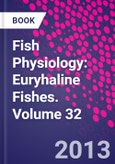The need for ion and water homeostasis is common to all life. For fish, ion and water homeostasis is an especially important challenge because they live in direct contact with water and because of the large variation in the salt content of natural waters (varying by over 5 orders of magnitude). Most fish are stenohaline and are unable to move between freshwater and seawater. Remarkably, some fishes are capable of life in both freshwater and seawater. These euryhaline fishes constitute an estimated 3 to 5% of all fish species. Euryhaline fishes represent some of the most iconic and interesting of all fish species, from salmon and sturgeon that make epic migrations to intertidal mudskippers that contend with daily salinity changes. With the advent of global climate change and increasing sea levels, understanding the environmental physiology of euryhaline species is critical for environmental management and any mitigative measures. This volume will provide the first integrative review of euryhalinity in fish. There is no other book that focuses on fish that have the capacity to move between freshwater and seawater. The different challenges of salt and water balance in different habitats have led to different physiological controls and regulation, which heretofore has not been reviewed in a single volume.
Please Note: This is an On Demand product, delivery may take up to 11 working days after payment has been received.
Table of Contents
1. Principles and patterns of osmoregulation and euryhalinity in fishSue Edwards
2. Osmosensing and autoregulation of euryhalinity
Dietmar Kueltz
3. Hormonal Control of euryhalinity
Yosio Takei and Stephen D. McCormick
4. Euryhaline Elasmobranchs
James S. Ballantyne and David I. Fraser
5. Smolt Physiology: the freshwater-seawater transitions in salmonids
Stephen D. McCormick
6. Freshwater-Seawater transitions in migratory fish
Joseph Zydlewski
7. Seawater-Freshwater transitions in migratory fish
J. Mark Shrimpton
8. Euryhalinity: Intertidal fish
William Marshall
9. Euryhalinity: extreme environments
Colin Brauner and Jonathan Wilson
10. Evolution of euryhalinity
Eric Schultz and Stephen D. McCormick








